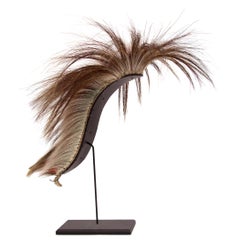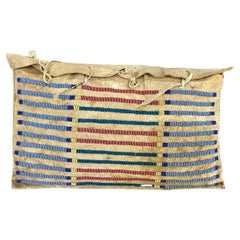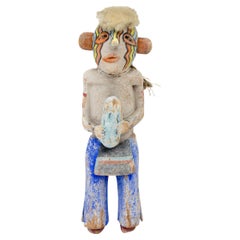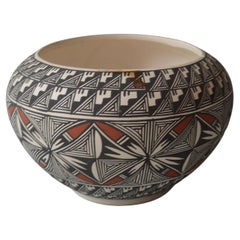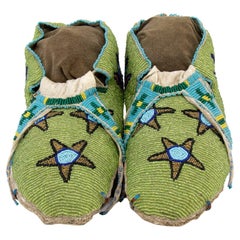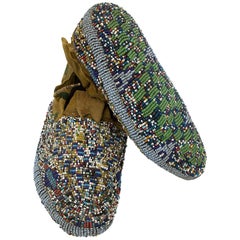Native American Art Tribal Art
to
4
4
2
2
2
2
1
1
1
1
4
4
4
4
4
97
54
25
14
9
Creator: Native American Art
Circa 1915 Pueblo Old Pawn Turquoise Cuff Bracelet in Stamped Ingot Silver
By Native American Art
Located in Denver, CO
This vintage Southwestern Native American cuff bracelet, crafted by a Pueblo artisan circa 1915, is a striking example of early Old Pawn jewelry. Made...
Category
Early 20th Century American Native American Native American Art Tribal Art
Materials
Multi-gemstone, Silver
19th C. Plains Native American Roach Headdress, Deer & Porcupine Hair
By Native American Art
Located in Denver, CO
This exceptional 19th-century Plains Indian roach headdress is a rare and visually striking example of traditional Native American ceremonial regalia. ...
Category
19th Century American Native American Antique Native American Art Tribal Art
Materials
Fur
Rare 19th-Century Crow Beaded Tepee Bag in Buffalo Hide, c.1860–1875
By Native American Art
Located in Denver, CO
This exceptional 19th-century Crow (Plains Indian) beaded tepee bag, dating circa 1860-1875, is a rare and authentic example of Native American craftsmanship and cultural heritage. E...
Category
Late 19th Century American Native American Antique Native American Art Tribal Art
Materials
Hide, Beads
Antique Hopi HeHeya Clown Kachina Doll with Watermelon, circa 1900–1925
By Native American Art
Located in Denver, CO
This rare antique Hopi HeHeya Clown Kachina doll, carved in the first quarter of the 20th century, is an exceptional example of traditional Hopi spiritual...
Category
Early 20th Century American Native American Native American Art Tribal Art
Materials
Wood
Related Items
Unusual 20th Century Kachina "style" Doll of a Navajo Figure with Large Hands
Located in Van Nuys, CA
Painted cottonwood Kachina "style" doll depicting a Navajo, circa 1940s. It is in good condition, with bright color. Kachina dolls were usually created to teach Hopi children the var...
Category
1940s American Native American Vintage Native American Art Tribal Art
Materials
Wood
$360 Sale Price
20% Off
H 7.5 in W 4.5 in D 4.5 in
Fine Vintage Laguna Pot Native American Pueblo
Located in London, GB
Fine Vintage Laguna Pot Native American Pueblo
Finely painted in linear geometric designs
Period 1970s signed on base R Reano
Condition Good
Category
20th Century American Native American Art Tribal Art
Materials
Pottery
Northern Plains Porcupine Hair Roach
Located in Coeur d'Alene, ID
Northern plains purple dyed porcupine guard hair surrounded by white and blue deer tail, twisted yellow cotton centre.
Period: First quarter of the 20th century
Origin: Northern Plains
Size: 18 1/2"
Family Owned & Operated
Cisco’s Gallery deals in the rare, exceptional, and one-of-a-kind pieces that define the history of America and the Old West. Our pieces range from American Indian to Cowboy Western and include original items of everyday life, commerce, art, and warfare that tamed America’s frontier. Our 14,000 square foot gallery opened in 1996 in beautiful Coeur d’Alene, Idaho.
Personal Service
Cisco’s operates on old fashioned values – honesty and integrity, and all of our items are backed by our money back guarantee. We appreciate the opportunity to earn your business. Whether you desire assistance with a jewelry purchase, choosing a gift, identification, or even selling – we hope to be your trusted source.
Headdresses, bustles and lances native american indian hair roaches headdresses...
Category
Early 20th Century American Native American Native American Art Tribal Art
Materials
Other
Large Signed Native American Hopi Original Mudhead Kachina Katsina Doll on Stand
By Native American Art
Located in Studio City, CA
A wonderfully handcrafted/detailed and decorated Native American Hopi Mudhead Kachina doll. Quite an unusually large work. A striking piece overall. Hand painted with leather and possibly turquoise (necklace) accompaniment.
Hopi katsina figures, also known as kachina dolls, are figures carved, typically from cottonwood root by the Hopi people. Initially, kachina dolls were made to instruct young girls and new brides about katsinas or katsinam, the immortal beings that bring rain, control other aspects of the natural world and society, and act as messengers between humans and the spirit world. The Mudhead or Koyemsi figure is viewed as a clown/joker figure who is responsible for laughter and entertainment at Hopi dances and ceremonial events. He plays drums and games to keep his audience engaged.
The piece is signed by the artist under the base.
From an extensive collection of Native American objects and artifacts. Would be a great addition to any Native American Art...
Category
20th Century American Native American Native American Art Tribal Art
Materials
Leather, Wood, Paint
$1,250
H 27 in W 10 in D 10 in
African Currency, 19th Century
Located in Dallas, TX
This set of 3 pieces of African currency is very interesting. Looking like some sort of ancient maraca, these 19th century pieces jingle and noise-make with each step. The dimensions...
Category
19th Century African Antique Native American Art Tribal Art
Materials
Metal
Circa 1900 Salish Totem
Located in Coeur d'Alene, ID
This old model Salish pole dates to around 1900 and was sold out of the Hudson Bay Fur Trading Co. in Seattle, WA. The pole depicts an inverted killer whale, although the identities of the other figures are unclear. There is a formline human face in profile carved in relief and painted on the front of the base. A rather unusual feature of this pole is the inlaid glass beads in the eyes of the figures and blowhole of the whale. Early model poles sometimes incorporated new, non-traditional materials into their work. A highly unusual and early pole. Northwest Coast cedar totem with original Hudson Bay sticker. Patinated with cabin smoke. 15"
PERIOD: Circa 1900
ORIGIN: Northwest Coast
SIZE: 15"
Family Owned & Operated
Cisco’s Gallery deals in the rare, exceptional, and one-of-a-kind pieces that define the history of America and the Old West. Our pieces range from American Indian to Cowboy Western and include original items of everyday life, commerce, art, and warfare that tamed America’s frontier. Our 14,000 square foot gallery opened in 1996 in beautiful Coeur d’Alene, Idaho.
Personal Service
Cisco’s operates on old fashioned values – honesty and integrity, and all of our items are backed by our money back guarantee. We appreciate the opportunity to earn your business. Whether you desire assistance with a jewelry purchase, choosing a gift, identification, or even selling – we hope to be your trusted source.
Totems...
Category
Early 20th Century American Native American Native American Art Tribal Art
Materials
Cedar
1950s Native American Navajo Pawn Silver & Petit Point Turquoise Bolo Tie
By Navajo
Located in San Juan Capistrano, CA
1950s Navajo-made Bolo Tie from New Mexico. Handcrafted from pawn .900 silver and set with turquoise, the rope is hand-woven leather, and the tips are silver.
Category
Mid-20th Century American Native American Native American Art Tribal Art
Materials
Silver
$325
H 2.13 in W 1.75 in D 0.13 in
Fine Vintage silver Turquoise Cuff bracelet ethnographic tribal jewellery
Located in London, GB
Fine Indian Vintage silver Turquoise Cuff bracelet ethnographic tribal jewellery
A vintage silver Cuff bracelet with multiple Turquoise cabochons
High grade silver
Category
20th Century Indian Native American Art Tribal Art
Materials
Silver
Early 20th Century Acoma Pueblo Pottery Olla
By Navajo
Located in Bradenton, FL
A very fine Acoma Pueblo, early 20th century polychrome Olla. Painted dark brown and orange design on a white ground, with large areas fired gray. Shrinka...
Category
Early 20th Century Native American Native American Art Tribal Art
Materials
Clay
Native Kiowa 19th Century Pictorial Child's Teepee
By Native American Art
Located in Coeur d'Alene, ID
Child's teepee depicting highly graphic battle scene painted on brain tanned deer skin. This piece was acquired from Wilma Silvey, age 89, in 2005, white woman, was handed down through her husband's family, Joseph Silvey (Silverfish). His father was "Long Hair Hanging" (Kiowa Comanche) and his mother...
Category
Late 19th Century American Native American Antique Native American Art Tribal Art
Materials
Other
Southwestern Native American Signed Hopi Kachina Katsina Doll in Display Case
Located in Studio City, CA
Nicely made and displayed. Signed by the artist on the base.
Kachina figures are believed to act as messengers between humans and the spirit world.
Would be a great addition to any...
Category
20th Century American Native American Native American Art Tribal Art
Materials
Wood, Paint
$395
H 10 in W 5.5 in D 5.5 in
19th Century Native American Hidatsa Arikara Medicine Shirt
Located in Coeur d'Alene, ID
Hidatsa Arikara medicine shirt worn by a warrior who deserved honors, pre-reservation. Horseshoes represent successful horse raids, and the six quilled eagle feathers signify war coups, scalps or battles. Would note, four real scalps possibly moved over from an earlier war shirt...
Category
19th Century American Native American Antique Native American Art Tribal Art
Materials
Hide
Previously Available Items
Antique Beaded Moccasins, Cree, Plains Indian, circa 1890, Star & Cactus Flowers
By Native American Art
Located in Denver, CO
Vintage 19th century Native American Beaded Moccasins, Cree (Plains Indian), circa 1890. Native tanned hide with glass trade beads in green, blue, yellow, red, and white, with pictor...
Category
Late 19th Century American Native American Antique Native American Art Tribal Art
Materials
Hide, Beads
H 6 in W 7.5 in D 9 in
Antique Native American Childs Ceremonial Beaded Moccasins, Cheyenne, circa 1900
By Native American Art
Located in Denver, CO
Cheyenne (Plains Indian), antique Native American child's moccasins, vintage late 19th or early 20th century. Meticulously created for wear by a ...
Category
Late 19th Century American Native American Antique Native American Art Tribal Art
Materials
Hide
H 2.75 in W 6 in D 6.25 in
Antique Native American Beaded Leggings, Plains, Early 20th Century
By Native American Art
Located in Denver, CO
A pair of antique Native American Plains Indian beaded leggings constructed of native tanned hide and fringed. Partially beaded in black, blue and whit...
Category
Early 20th Century American Native American Native American Art Tribal Art
Materials
Hide
Antique Native American Beaded Pouch, Athapaskan ‘Northwest Coast’, 1820s-1850s
By Native American Art
Located in Denver, CO
This remarkable antique Northwest Coast Native American hide pouch was created by a member of the Athapaskan tribe (North American Indian) around the middle of the 19th century, known as the Classic Period of American Indian art (predating the reservation era). The beads on the suspensions are Padre beads...
Category
Mid-19th Century American Native American Antique Native American Art Tribal Art
Materials
Hide
H 9.5 in W 6.5 in L 9.5 in
Hand-Carved Wooden Native American or Eskimo ‘Alutiiq/ Sugpiag’ Mask
By Native American Art
Located in Studio City, CA
A nicely carved Eskimo (likely either Alutiiq or Sugpiag Native American people of the Kodiak Archipelago). Mask was acquired from a collection that consisted of items purchased from...
Category
20th Century American Tribal Native American Art Tribal Art
Materials
Wood
Native American Woven Tray or Basket
By Native American Art
Located in Studio City, CA
A beautifully and intricately woven Native North American woven tray or basket. Wonderful craftsmanship and detail. We are not sure of what particular tribe this is from but it was a...
Category
20th Century American Native American Native American Art Tribal Art
Antique Native American Beaded Telescope Case, Blackfeet 'Plains', 1875-1900
By Native American Art
Located in Denver, CO
A 19th century American Indian beaded telescope case (Blackfoot/Blackfeet). The case is composed of native tanned hide and beaded in red, yellow, pumpki...
Category
19th Century American Native American Antique Native American Art Tribal Art
Materials
Brass
H 26.5 in W 9.5 in D 1.5 in
Pair of Beaded Bandolier Bags, Winnebago/Chippewa 'Ojibwa', 19th Century
By Native American Art
Located in Denver, CO
Overall dimensions as displayed are 37 x 23 inches.
Left:
Winnebago, circa 1870
measures 37 x 10.5 inches
An exceptional early bandolier bag created during the Classic period (...
Category
Late 19th Century American Native American Antique Native American Art Tribal Art
Materials
Beads
Very Early Pair of Beaded Moccasins, Prairie "Woodlands", circa 1850
By Native American Art
Located in Denver, CO
A rare early pair of Classic Period (Pre-Reservation era) soft-soled moccasins. Constructed of native tanned hide and exquisitely beaded with trade beads. The cuffs are adorned in ri...
Category
19th Century American Native American Antique Native American Art Tribal Art
Materials
Hide
Collection of Three Native American 'Plains Indian' Roach Headdresses
By Native American Art
Located in Denver, CO
A group of three antique Roach Headdresses/Hair Ornaments. Custom display stands are included.
Left: Plains Roach, circa 1890. Made of badger and po...
Category
Late 19th Century American Native American Antique Native American Art Tribal Art
19th Century Plains Pouch with Pictographs in Beadwork
By Native American Art
Located in Denver, CO
Transitional plains pouch from the last quarter of the 19th century. Constructed of native tanned hide and partially beaded with trade bead. Side 1: three buffalo pictographs; side 2...
Category
Late 19th Century American Native American Antique Native American Art Tribal Art
Materials
Hide
Antique Northwest Coast Native American Carved Horn Spoon, Haida, 19th Century
By Native American Art
Located in Denver, CO
An American Indian/Northwest coast spoon or ladle exquisitely carved with animal effigies. Custom display stand is included. Overall dimensions w...
Category
19th Century American Native American Antique Native American Art Tribal Art
Materials
Horn
H 8.5 in W 3 in D 3 in
Native American Art tribal art for sale on 1stDibs.
Native American Art tribal art are available for sale on 1stDibs. These distinctive items are frequently made of animal skin and are designed with extraordinary care. There are many options to choose from in our collection of Native American Art tribal art, although brown editions of this piece are particularly popular. Prices for Native American Art tribal art can differ depending upon size, time period and other attributes — on 1stDibs, these items begin at $2,120 and can go as high as $11,500, while a piece like these, on average, fetch $9,500.
Questions About Native American Art Tribal Art
- 1stDibs ExpertOctober 12, 2021A Native American artifact is any object that provides insight into the lives and history of native people in America. These items range from carved stone pipes, weapons for hunting, tools for cooking, pottery, jewelry and more. Find a collection of artifacts on 1stDibs today.
- 1stDibs ExpertApril 5, 2022In the Native American language of Powhatan spoken by the Algonquian indigenous people, moccasin refers to a hand-sewn suede bootie. Today, people may call any shoes that feature stitched round toes by the name. Shop a variety of moccasins on 1stDibs.
- 1stDibs ExpertApril 5, 2022There are a wide array of different dolls made by the various tribes of Native American peoples. Some of the most well-known are the kachinas made by the Navajo, Hopi and Pueblo peoples. Shop an array of Native American dolls on 1stDibs.
- 1stDibs ExpertApril 5, 2022What Native Americans used to produce baskets varied from tribe to tribe. Generally, craftsmen used whatever materials were readily available. In the Northeast, sweet grass was a common material, while pine needles and wicker are frequently found in baskets produced by tribes in the Southeast. Find a range of vintage and antique baskets on 1stDibs.
- 1stDibs ExpertNovember 13, 2024To identify Native American beadwork, first consider the materials. Indigenous American artisans often produce beads out of glass and natural materials, such as shells, bone and wood, and use metal and plastic in their pieces less frequently. Older pieces will usually be held together by sinew, while newer examples will typically feature thread. Regardless of age, Native American beadwork will typically be expertly crafted, so pieces usually have tight, even stitching with no visible gaps. Familiarizing yourself with stitching techniques used by various tribes can also be helpful. You can find images of authentic beadwork on trusted online resources to refer to as you complete the identification process. Alternatively, you can have a certified appraiser or experienced antique dealer evaluate your piece. On 1stDibs, shop a wide variety of textiles and garments that feature Native American beadwork.
- 1stDibs ExpertApril 5, 2022To identify Native American baskets, you can research the patterns using authoritative online resources to try and determine which tribe produced it. However, many replicas exist and there are many tribes that produced baskets. As a result, it is a good idea to consult a licensed appraiser. On 1stDibs, find a variety of expertly vetted Native American baskets.
- 1stDibs ExpertApril 5, 2022What Native American drums are called varies by type. Ones designed to rest in the player's lap are hand drums, while instruments that hold water used primarily by the Iroquois and Yaqui are water drums. Large freestanding drums that produce loud percussive sounds are powwow drums. The Aztec and Hopi used foot drums. You'll find a range of Native American drums on 1stDibs.
- 1stDibs ExpertApril 5, 2022Native American slippers are called moccasins. Moccasins are characterized by their U-shaped puckered toe design and are crafted with various leathers such as sheepskin or buffalo. They may or may not be decorated with beading. Shop a collection of authentic moccasins from some of the world’s top sellers on 1stDibs.
- 1stDibs ExpertApril 5, 2022It depends on which region the beads were made since they were created out of available materials found in the land around them. In the Eastern Woodlands, white and purple marine shell beads were called “wampum”. You can shop a collection of Native American beadwork from some of the world’s top boutiques on 1stDibs.
- 1stDibs ExpertApril 5, 2022The most well-known Native American blankets come from Navajo weaving, which are prized by collectors worldwide. Originally utilitarian, the Navajo people began creating blankets specifically for export and tourism in the 19th century. Shop a collection of Navajo blankets from some of the world’s top sellers on 1stDibs.
- 1stDibs ExpertApril 5, 2022What a Native American headdress represents depends on what tribe produced it. In general, headdresses may symbolize a person's status within the tribe or serve as a sign of bravery during battle. You'll find a selection of Native American headdresses on 1stDibs.
- 1stDibs ExpertApril 5, 2022What rattles symbolize in Native American culture varies from tribe to tribe. Some indigenous people believe they serve as connections between the natural and spiritual worlds. Others believe they represent the ties between animals, plants and minerals. In addition, rattles sometimes symbolize independence. On 1stDibs, find a selection of Native American rattles.
- 1stDibs ExpertOctober 30, 2024Yes, some Native American jewelry is worth something. As with other types of jewelry, many pieces are made of fine materials, such as sterling silver, turquoise, jasper and lapis lazuli. Jewelry produced by Native American artists may also have value based on its age, style, type and other factors. Find a large selection of Native American jewelry on 1stDibs.
- 1stDibs ExpertApril 5, 2022To tell if Native American jewelry is real, have it evaluated by a licensed and experienced appraiser. Because every tribe has its own designs and identifying characteristics, it is usually not possible to determine authenticity using only online resources. Find a collection of expertly vetted Native American jewelry on 1stDibs.
- 1stDibs ExpertMay 5, 2023A number of Native American tribes are known for pottery, including the Cheyenne, Cherokees, Hopi, Iroquois, Navajo Pueblo and Shoshone. Artisans from each indigenous group have their own style. For example, Hopi pottery is often a red-brown color and decorated with black designs, while Navajo pottery is deeper brown and usually has a high-gloss finish. Find a selection of Native American pottery on 1stDibs.
- 1stDibs ExpertApril 5, 2022Northwest Coast native art describes works of art produced by indigenous people who live along the Northwest Coast of the U.S. and Canada. Some tribes who inhabit the region include the Haida, Heiltsuk, Kwakwaka'wakw, Nuu-chah-nulth, Nuxalk, Tlingit and Tsimshian. On 1stDibs, find a collection of Northwest Coast native art.
- 1stDibs ExpertApril 5, 2022The two types of Native American beadwork are called the “lazy stitch” or “lane stitch” and the “tack stitch” or “flat stitch”. You can shop a collection of Native American beadwork from some of the world’s top boutiques on 1stDibs.
Recently Viewed
View AllMore Native American Art Furniture
Native American Art Native American Objects
Native American Art Sculptures and Carvings
Native American Art Painted Furniture
Native American Art Decorative Objects
Native American Art Rugs and Carpets
Native American Art Building and Garden Elements
Native American Art Decorative Baskets
Native American Art Models and Miniatures
Native American Art Vases
Native American Art Historical Memorabilia
Native American Art Musical Instruments
Native American Art Collectible Jewelry

